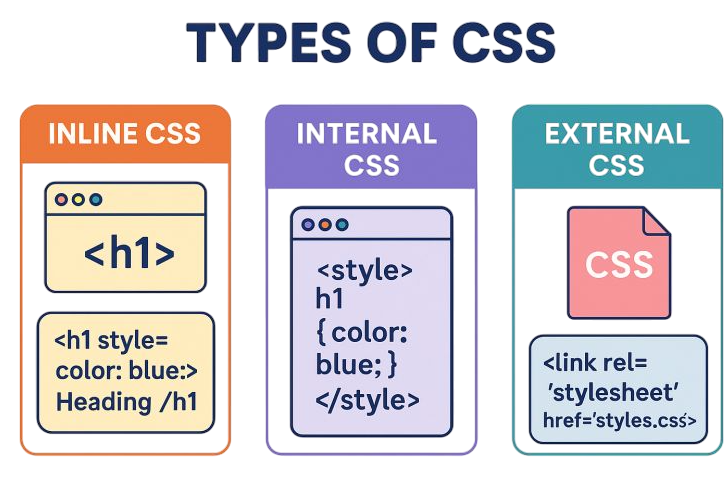
- Introduction to CSS Styling Methods
- What is Internal CSS Style?
- Syntax of Internal CSS
- <style> Tag in HTML Head
- Advantages of Internal CSS
- Limitations Compared to External CSS
- Internal CSS vs Inline and External CSS
- Examples of Internal CSS
- When to Use Internal Styling
- Styling Multiple Elements
- Browser Behavior and Compatibility
- Summary
Introduction to CSS Styling Methods
Internal CSS (Cascading Style Sheets) is a styling methods used in HTML documents where CSS rules are written within the <style> tag inside the <head> section. This method is effective for applying unique styles to a single HTML page. Internal CSS is ideal when you want to style multiple elements consistently on one page without affecting others. It allows developers to keep HTML structure and style rules together in the same file, making it easier to manage styles for small projects or isolated pages. To complement this inline styling approach with broader development expertise, exploring Web Developer Training reveals how mastering technologies like HTML, CSS, JavaScript, and modern frameworks equips professionals to build scalable, maintainable web applications balancing rapid prototyping with long-term design flexibility.

CSS offers three main methods for applying styles to HTML elements: Inline CSS, Internal CSS, and External CSS. Inline CSS involves adding style directly within HTML tags using the style attribute. Internal CSS is written in the <head> of the HTML file, while External CSS is stored in a separate .css file and linked to HTML using the <link> tag. Each method has its use case based on project size, team collaboration, and reusability.
To Earn Your Web Developer Certification, Gain Insights From Leading Web Developer Experts And Advance Your Career With ACTE’s Web Developer Courses Today!
What is Internal CSS Style?
Internal CSS is a method of defining CSS rules directly within an HTML file using the <style> tag. These styles are placed within the <head> section of the HTML document. Internal CSS allows for centralized styling of elements on a single page, meaning all styles apply only to that specific document. To complement this page-specific styling approach with robust code management practices, exploring Guide to Git and Version Control reveals how developers can track changes, collaborate efficiently, and maintain clean version histories ensuring that even single-page projects benefit from structured workflows and reliable source control. Unlike inline CSS, which applies to individual elements, internal CSS can define rules that apply to classes, IDs, and element types across the page.
Syntax of Internal CSS
The syntax of internal CSS follows standard CSS formatting. Inside the <style> tag, you write CSS selectors followed by curly braces containing property-value pairs. Here is an example of the basic syntax: To complement this foundational styling knowledge with scalable architectural principles, exploring What are Microservices reveals how modular services each responsible for a specific functionality enable rapid deployment, fault isolation, and flexible scaling across distributed systems.
- <head>
- <style>
- body {
- background-color: #f0f0f0;
- font-family: Arial, sans-serif;
- }
- h1 {
- color: blue;
- text-align: center;
- }
- p {
- font-size: 14px;
- color: gray;
- }
- </style>
- </head>
Each selector targets an HTML element and applies the specified styles.
Would You Like to Know More About Web Developer? Sign Up For Our Web Developer Courses Now!
<style> Tag in HTML Head
The <style> tag is the HTML element used to include internal CSS. It must be placed within the <head> section of the HTML document. This ensures the browser reads and applies the styles before rendering the page content. The <style> tag does not display anything on the webpage; it only serves to define the CSS rules. Using this tag, developers can structure the styling logic in one central block, which improves readability and manageability compared to using inline CSS across multiple elements. To complement this centralized styling approach with versatile programming capabilities, exploring What is Python Programming reveals how Python’s clean syntax, dynamic typing, and extensive libraries make it ideal for rapid application development, data analysis, automation, and web integration across diverse platforms.
Advantages of Internal CSS
Internal CSS provides several benefits for web development: it allows centralized styling within a single HTML document, simplifies quick edits, and improves readability for small-scale projects. To complement this styling approach with foundational programming knowledge, exploring Need To Know About Python List reveals how Python lists being ordered, mutable, and versatile serve as essential data structures for storing, manipulating, and iterating over collections in dynamic web and software applications.
- Centralized Styling for One Page: Simplifies management of CSS for single-page websites or pages requiring unique styling.
- Better Organization: Styles are separated from HTML content but remain within the same document.
- No External Dependencies: Eliminates the need to load additional CSS files, improving load speed and offline accessibility.
- Easy Debugging: Styles are co-located with markup, allowing developers to quickly identify and fix issues.
- Overrides External Styles: Internal CSS has higher specificity than external CSS, enabling intentional overrides.
Are You Interested in Learning More About Web Developer? Sign Up For Our Web Developer Courses Today!
Limitations Compared to External CSS
Despite its usefulness, internal CSS has several limitations: it lacks reusability across multiple pages, increases page size, and can lead to maintenance challenges in larger projects. To complement this understanding of styling constraints with practical development expertise, exploring Web Developer Training reveals how mastering HTML, CSS, JavaScript, and modern frameworks empowers professionals to build scalable, maintainable web applications leveraging best practices in styling, structure, and performance optimization.
- Not Reusable Across Pages: Applies only to one HTML file, preventing style reuse across multiple documents.
- Longer Load Time for Large Files: Embedding large style blocks increases HTML file size, potentially slowing down page load times.
- Not Ideal for Large Projects: Managing styles across many HTML files becomes cumbersome without an external stylesheet.
- Duplication of Styles: Repeating internal CSS across multiple pages leads to maintenance challenges.
- Limited Collaboration: External CSS allows parallel work on HTML and stylesheets, which is preferred in team environments.
Internal CSS vs Inline and External CSS
Internal CSS resides in the <head> section of a single HTML document and applies to that page only. Inline CSS applies styles directly within the HTML tag using the style attribute, offering the highest specificity but being messy and hard to maintain. External CSS stores styles in a separate .css file linked to HTML, promoting reusability, maintainability, and separation of concerns. To complement these styling strategies with a broader understanding of development roles, exploring What Is a Software Developer reveals how professionals conceptualize, design, code, test, and maintain software systems transforming user needs into functional applications across industries.
| Feature | Inline CSS | Internal CSS | External CSS |
|---|---|---|---|
| Location | In tag attribute | In <style> tag | In separate file |
| Scope | Single element | Single page | Entire website |
| Reusability | None | Low | High |
| Maintain | Poor | Moderate | Excellent |
| Performance | Fast load, small | Slower for large | Best for caching |
Examples of Internal CSS
Here are some practical examples of internal CSS:
- <!DOCTYPE html>
- <html>
- <head>
- <style>
- h2 {
- color: green;
- }
- .highlight {
- background-color: yellow;
- font-weight: bold;
- }
- #main-section {
- padding: 20px;
- border: 1px solid #ccc;
- }
- </style>
- </head>
- <body>
- <h2>Welcome to My Website</h2>
- <p class=”highlight”>This paragraph is highlighted.</p>
- <div id=”main-section”>This is the main content area.</div>
- </body>
- </html>
In this example, internal CSS styles an h2 element, a paragraph with class highlight, and a div with ID main-section.
When to Use Internal Styling
Internal CSS is very effective in different situations. It is best for single-page websites or applications that need a unique style for the whole page. When creating HTML email templates with specific style limits, internal styling can be a great option. It allows for quick testing or prototyping of new designs without complicated setups. To complement this rapid development approach with language-level efficiency, exploring Kotlin vs Java reveals how Kotlin’s concise syntax and null safety features offer cleaner code and faster deployment compared to Java’s robust, time-tested architecture especially in mobile and backend development scenarios. If you need to change styles from external CSS files without altering them, internal CSS offers a simple solution. This method also works well for landing pages that need unique styling to grab attention. While it may not be the best choice for multi-page websites, using internal CSS can make development and testing easier for individual pages. This makes it a valuable tool for any web developer.
Styling Multiple Elements
Internal CSS allows for efficient styling of multiple elements by using:

- Element selectors (e.g., p, h1) for global style rules.
- Class selectors (e.g., .btn, .nav) to apply styles to multiple elements with the same class.
- ID selectors (e.g., #footer, #header) for unique elements.
- Group selectors (e.g., h1, h2, h3) to apply the same styles to multiple tags.
Example:
- <style>
- h1, h2, h3 {
- font-family: ‘Arial’;
- color: darkblue;
- }
- .box {
- border: 1px solid black;
- padding: 10px;
- margin: 5px;
- }
- </style>
This lets developers maintain consistent visual themes across the page with fewer lines of code.
Browser Behavior and Compatibility
Internal CSS is universally supported by all modern browsers, including Chrome, Firefox, Safari, Edge, and Opera. However, improper placement of the <style> tag or conflicting styles can lead to inconsistent rendering. To complement this understanding of browser-based styling with core programming principles, exploring What is Abstraction in Java reveals how developers can simplify complex systems by exposing only essential features using abstract classes and interfaces to enforce structure, reduce code duplication, and improve maintainability across scalable applications.
To ensure optimal compatibility:
- Always place the <style> tag inside the <head>
- Use valid CSS syntax
- Avoid inline styles unless necessary
- Test across different browsers and devices
Also, browser developer tools can help inspect and debug internal styles to resolve any compatibility issues.
Summary
Internal CSS is a powerful styling method for HTML documents that need page-specific customization. It offers a balance between organization and flexibility for single-page applications or documents requiring unique styles. While it lacks the reusability of external CSS, its centralized approach is beneficial for rapid development, testing, or small-scale projects. To complement such styling strategies with broader development expertise, exploring Web Developer Training reveals how mastering HTML, CSS, JavaScript, and modern frameworks equips professionals to build scalable, maintainable web applications balancing speed with structure across diverse project scopes. Understanding when and how to use internal CSS along with its limitations and benefits allows web developers to structure their code efficiently and deliver polished, visually appealing webpages.



